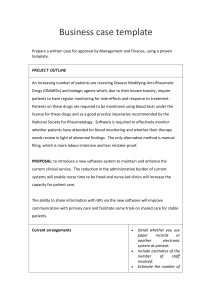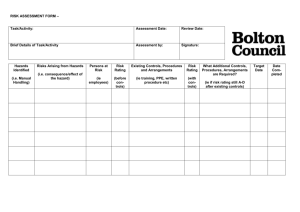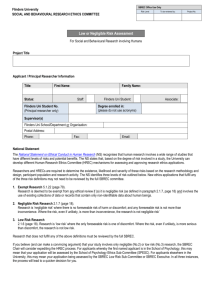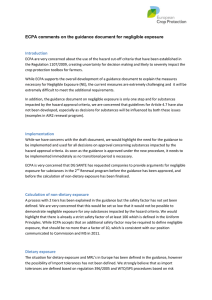HEARING EPA presentation (pptx)
advertisement
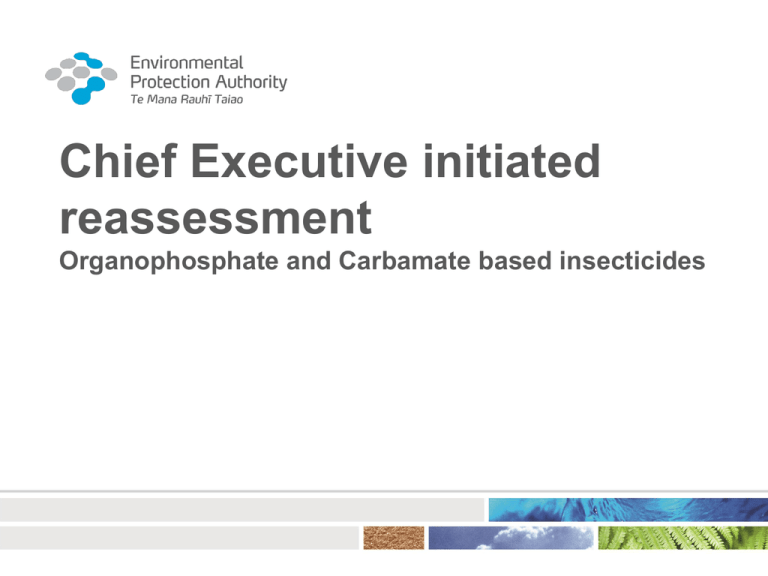
Chief Executive initiated reassessment Organophosphate and Carbamate based insecticides New reassessments approach Moving from single substance to group reassessments Older substances, often removed or restricted by other jurisdictions Engaging early – go out with early thinking Aim: Avoid perverse outcomes Consistent controls to manage risk Greater certainty about tools available for use in medium term More efficient use of resources Consultation Call for Information To identify those that may have high risks To obtain use information Feasibility of possible controls or other controls to mitigate risk Hui Northland, Bay of Plenty, Rotorua and Marlborough Scope of the reassessment acephate carbarylc chlorpyrifos diazinon dichlorvos dimethoate fenamiphos fenitrothion phoxim c=carbamates maldison methamidophos methomylc phorate pirimicarbc pirimiphos-methyl prothiofos oxamylc terbufos pyrazophos benomylc carbofuranc carbosulfanc chlorpyrifos-methyl dichlofenthion ethion famphur isazofos omethoate HSNO Process May approve if the positive effects of the substance outweigh the adverse effects • If risks are negligible then the approvals should be retained • If additional controls make the risks negligible, then the approval should be retained with those additional controls. • If the risks are non-negligible even with extra controls a risk/benefit analysis is conducted and: • If benefits are greater than the risks the approval is recommended to be retained • If risks are greater than benefits the approval is recommended to be revoked either with or without a phaseout period Evaluation Risk vs Benefit Qualitative descriptors allow a risk or a benefit to be negligible, low, medium or high to focus comparisons Likelihood and magnitude for risks and benefits Page 43 – 45 of the consultation report Example Diazinon widely used high risks and high benefits effective alternatives not yet available Analysis of risks Risk is a function of exposure and hazard Exposure estimated using models/measured data Use patterns established from product label and stakeholder feedback Hazard: Use threshold values derived by other regulators Risks assessed with and without additional controls Analysis of risks Operators Re-entry workers Bystanders Aquatic environment Birds Bees Analysis of risks Risk Quotient = Predicted exposure/threshold value Target Risk Quotient is <1 Risks - Qualitative Descriptors Human health Risk Quotient Risk Parameter Operators Re-Entry workers Bystanders <1 Overall Negligible Negligible Negligible Magnitude Minor Minor Moderate Likelihood Likely Very unlikely Unlikely Overall Low Negligible Low Magnitude Moderate Moderate Moderate Likelihood Likely Unlikely Unlikely Overall Medium Low Low Magnitude Major Major Major Likelihood Highly likely Likely Unlikely Overall High Medium Medium Risk Quotient Risk parameter Aquatic Birds Bees <1 Overall Negligible Negligible Negligible Magnitude Minor Minor Minor Likelihood Very unlikely Unlikely Very unlikely Overall Negligible Low Negligible Magnitude Moderate Minor Minor Likelihood Unlikely Highly likely Very unlikely Overall Low Medium Negligible Magnitude Major Major Minor Likelihood Likely Highly likely Very unlikely Overall Medium High Negligible >1-10 >10-100 >100 Environment >1-10 >10-100 >100 Benefits - Qualitative Descriptors Marginal cumulative benefits Category Criteria Very unlikely No evidence provided of actual use Possible Used only rarely or when needed Likely Some current use across industry Highly likely Significant and regular use across industry Minor Difficult to ascertain material impacts. Moderate Medium term regional effects with some national implications for GDP - $0-$15 million Major Measurable beneficial effect on GDP - $15-$50 million Massive Significant on-going beneficial effect on GDP Above $50 million Magnitude Likelihood Minor Moderate Major Massive Very unlikely Negligible Negligible Negligible Negligible Possible Negligible Low Medium Medium Likely Negligible Low Medium High Highly likely Negligible Medium High High Generic Benefits Efficacy Broad spectrum Lower application rates Cheaper Short pre-harvest intervals Short re-entry intervals Maximum Residue Limits Resistance management Biosecurity Specific Benefits Many OPCs are particularly effective in controlling specific pests. This makes them beneficial on a number of crops where these pests are difficult to control Diazinon to control grass grub on pasture Supports large industries = large contribution to GDP Specific pest to NZ No effective alternatives – ongoing research Approach to controls AIM: Reduce risk levels to, or close to, negligible Controls are risk reduction measures, intended to reduce exposure to human health / environment Default controls (arising from hazardous properties – s77) Additional controls (to manage risks not addressed by default controls, reflect parameters of scenarios – s77A) Risks identified to the receptors identified in the risk assessment Operators, re-entry workers, bystanders Aquatic and terrestrial environment, birds, bees Additional controls toolbox developed with stakeholders Controls toolbox Example controls Operational • prescriptive PPE requirements • permitted application methods (e.g. ground-based application only), maximum application rates and frequencies • buffer zones and spray drift reduction measures (NZS:8409) • restricted entry intervals (REI) • notifications and signage Obligations • Approved Handlers only • Authorised Person • Labelling statements Restrictions • indoor use only • phase out/revocation Recommendations Based on balance of risks and benefits Controls selected to mitigate risks as far as possible Recommendations – Diazinon Very high risks – but also very high benefits Long phase-out period proposed to allow development of alternatives – plus additional controls e.g. Maximum application rates Semi-automated equipment for indoor application No hand-held application of granules Key issues raised in submissions • • • • • Home garden uses ADI/MRL relationship Biosecurity uses Information challenges/data gaps UK COT Updated recommendations Retain dimethoate Retain outdoor uses of pirimiphos-methyl & methomyl Biosecurity – Authorised Person-only control for fenamiphos after 5 years; Extend AP control to all OPCs we’re retaining Extend phase-in period to 2 years Change definition of automated application in greenhouses Remove droplet size requirements for chlorpyrifos and diazinon Allow shorter buffer zones through COP New label warning for bee risks

